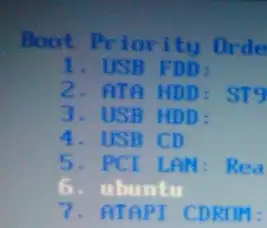I've just installed and uninstalled ubuntn and win7 on my laptop for several times, and this happened: see the pictures below.
The first one is about BIOS:

The second is what I got after pressed F12:

I don't know when it appeared for the first time. But, how could this happen?
update===========
@con-f-use: I've used a thumb drive named "Install Ubuntu" to install ubuntu, BIOS Version: 53CN14WW.
@CYREX, @jo-erlend: Yeah, it looks really cool ;) I'm wondering if this could happen on another laptop
@Col: I've pulled out all the USBs while taking those images.
@James Henstridge: I don't know if it's a EFI BIOS, how to distinguish?
update===========
Is there any test that i can run to figure out if it's a uefi/efi bios?